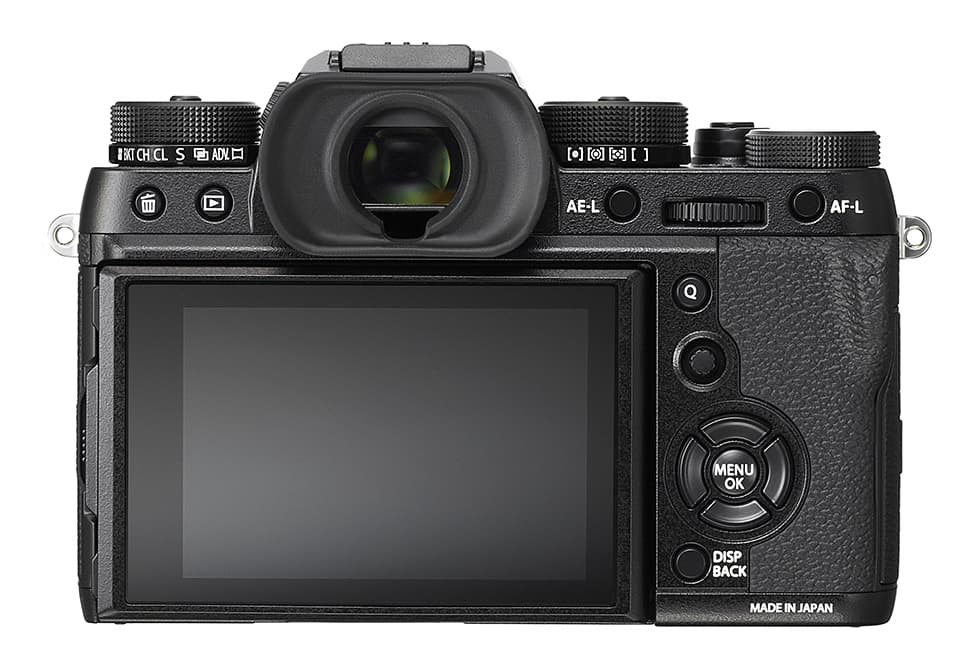[The update at the end of this article adds details of a firmware update the X-Pro2]
VIDEO INTERVIEW: Photographers are ditching DSLRs for mirrorless cameras
The X-T2 is a weather-sealed model boasting improved EVF and an autofocus system designed to make it easier to shoot moving subjects in tricky conditions.
Commenting on the improved AF, Fuji claims: ‘The high-speed processing power and the use of improved algorithms have significantly improved the basic autofocus performance, improving the focusing performance on points of light, low-contrast objects and subjects with fine and delicate textures such as bird feathers and animal fur, which have previously been the weakness of phase detection AF.’
Contrast detect AF has also been improved, doubling the data readout speed, with the ability to focus in low light, down to -3EV. The number of focusing points has been raised to 325, allowing users to select from 91 to 325 points.

Borrowing its looks from the X-T1, Fuji hopes the X-T2 will appeal to sports and wildlife photographers. It says these genres were previously considered ‘difficult with mirrorless cameras’.
‘We want the X-T2 to sit alongside the X-Pro2,’ said Theo Georghiades general manager for electronic imaging at Fujifilm UK.
He told AP: ‘We have two different camps – an SLR style [the X-T2 and X-T1] and a rangefinder style [XPro2] to cover different types of photography.’
Due to go on sale in September and priced £1,399 (body only), the X-T2 will be the first X-series camera to feature 4K video, which also allows videographers to apply the Film Simulation functions used for still images.
The X-T2 is also the first in the line to include a three-way tilting screen.

Other improvements over the X-T1 (which was launched in 2014) include the addition of a 24.3-million-pixel X-Trans III, APS-C size imaging sensor with no low-pass filter (the X-T1 carried a 16.3MP sensor).
‘Despite having a pixel count 1.5 times that of the X-T1, the new device and its enhanced signal processing technology have successfully controlled digital noise even further,’ the firm added in a statement.
Maximum ISO has been raised to 12,800, compared to ISO 6,400 on the X-T1.
Weighing 507g, the X-T2 is built to be rugged yet lightweight and includes a five-frames-per-second continuous shooting burst rate with live view – compared to 3fps on the X-T1 – plus a claimed shorter start-up time, shooting interval and shutter release lag.
Built to be dust and water resistant, the X-T2 incorporates 63 weather seals and AF-C custom settings to help improve focus tracking. The camera can cope with temperatures down to -10°C, according to Fuji.
The EVF has also been enhanced, allowing it to display up to 100fps, while maintaining a magnification ratio of 0.77x and display time lag of ‘0.005secs’.
Fuji claims to have more than halved the viewfinder blackout time – the period in which the live view display temporarily blacks out while the camera reads the image data.
The addition of an optional VPB-XT2 battery grip should help handling when using a telephoto lens and extend the burst rate to up to 11 frames per second.
The X-T2 boasts an electronic shutter burst rate of 14fps using the grip.The grip will be available separately priced £299.99.
The OLED viewfinder carries a resolution of 2.36m dots, the same as that in the X-T1, which also features the same 3in 1.04m-dot LCD screen. Fuji told AP it has no current plans to phase out the X-T1.
• Fuji is set to release new firmware for the X-Pro2, allowing it to stand ‘side-by-side’, as the firm’s second X-series flagship camera. Update version 2.0 for the X-Pro2 will add the new AF algorithms of the X-T2 for ‘faster and more accurate autofocus’. The firmware update is due out in October.








